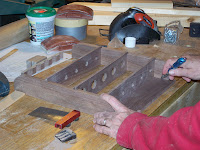This morning I am back at work on David B’s storage trailer.
My first task of the day is to sand the racks smooth. Here I come up against my first quandary; how much sanding should I do? The furniture-maker in me wants to hunker in and sand until it is all satiny smooth and a pleasure to touch. But that means investing a lot of time and effort; and time is money. I don’t want to gouge my customer by investing more time than is needed and running up the bill. This is, after all, not a piece of furniture but a storage trailer. Although I have seen many articles about woodworkers who built a workbench or cabinet for their shop and employed all the finest furniture making techniques in building it – yielding a very classy, show-piece, piece of shop furniture and an immense source of pride – no one was paying them an hourly rate to do so. Perhaps here “utility” is the key phrase. So, I sand away all the fuzzy bits and knock sharp edges off to help prevent splinters, but don’t go crazy with it.
Next I drill pocket holes in the uprights of the racks. The blue jig clamps to the wood and guides the drill bit, chucked into a portable drill, at the proper angle and to the right depth. The special bit is stepped, the wider part drills the main pocket allowing the screw head to be sunk below the surface of the wood. The smaller stub on the end of the bit drills the pilot hole for the screw shank. The flat end of the larger hole provides a shoulder where the washer headed screw seats. Because it is flat, not V shaped like a normal flat-head wood screw, there is no tendency for it to split the wood when tightened.
I drill two pockets at each attachment point, one from each side of the rack. This will prevent any tendency at all for the screws to twist the rack around to the side. This is not normally a problem with pocket hole screws, but in this case a little overkill won’t hurt anything. And since I’m not gluing the rack in place (David may want to move them some day) I want these connections to be as sturdy as possible. A little touch-up sanding and I’m ready for a test fit.
Using yard tools I have on hand, I determine how far in from the ends each rack needs to be, check to be sure I won’t hit any steel ribs inside the plywood wall covering, and mount the racks. I am pleased with the rigidity that this system gives the racks. I install some tools to check the fit. Wide headed tools, like a leaf rake, could cause problems by encroaching on the space for other tools, but that can be gotten around by simply flipping the tool above and below around so the handle end is adjacent to the rake head. (I actually planned it that way) Vertical spacing seems to have worked out properly as well. Each implement can be lifted clear of the hook without running into the tool above it, yet little space is consumed as excess clearance. I believe the hooks are deep enough to contain the tools even as the trailer bounces along a rough road. Within reason anyway!
I’d say this is going to work. Therefore I need to make four more racks just like these, then I will turn my attention to the swing wall they will mount on.
One last note: D-handle tools (grain scoop, short spade, etc) do not go in this rack, only long, straight handled tools. The D-handle tools will go elsewhere.


















